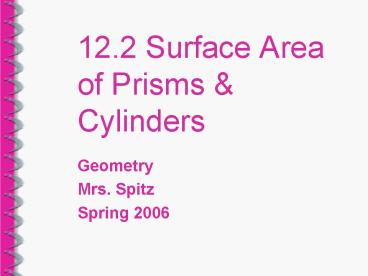12.2 Surface Area of Prisms - PowerPoint PPT Presentation
1 / 16
Title:
12.2 Surface Area of Prisms
Description:
12.2 Surface Area of Prisms & Cylinders Geometry Mrs. Spitz Spring 2006 Objectives/Assignment Find the surface area of a prism. Find the surface area of a cylinder. – PowerPoint PPT presentation
Number of Views:73
Avg rating:3.0/5.0
Title: 12.2 Surface Area of Prisms
1
12.2 Surface Area of Prisms Cylinders
- Geometry
- Mrs. Spitz
- Spring 2006
2
Objectives/Assignment
- Find the surface area of a prism.
- Find the surface area of a cylinder.
- Assignment WS 12.2 A
3
Finding the surface area of a prism
- A prism is a polyhedron with two congruent faces,
called bases, that lie in parallel planes. The
other faces called lateral faces, are
parallelograms formed by connecting the
corresponding vertices of the bases. The
segments connecting these vertices are lateral
edges.
4
Finding the surface area of a prism
- The altitude or height of a prism is the
perpendicular distance between its bases. In a
right prism, each lateral edge is perpendicular
to both bases. Prisms that have lateral edges
that are not perpendicular to the bases are
oblique prisms. The length of the oblique
lateral edges is the slant height of the prism.
5
Note
- Prisms are classified by the shape of their
bases. For example, the figures above show one
rectangular prism and one triangular prism. The
surface area of a polyhedron is the sum of the
areas of its faces. The lateral area of a
polyhedron is the sum of the areas of its lateral
faces.
6
Ex. 1 Finding the surface area of a prism
- Find the surface area of a right rectangular
prism with a height of 8 inches, a length of 3
inches, and a width of 5 inches.
7
(No Transcript)
8
Nets
- Imagine that you cut some edges of a right
hexagonal prism and unfolded it. The
two-dimensional representation of all of the
faces is called a NET.
9
Nets
- In the net of the prism, notice that the lateral
area (the sum of the areas of the lateral faces)
is equal to the perimeter of the base multiplied
by the height.
10
Ex. 2 Using Theorem 12.2
11
Ex. 2 Using Theorem 12.2
12
Finding the surface area of a cylinder
- A cylinder is a solid with congruent circular
bases that lie in parallel planes. The altitude,
or height of a cylinder is the perpendicular
distance between its bases. The radius of the
base is also called the radius of the cylinder.
A cylinder is called a right cylinder if the
segment joining the centers of the bases is
perpendicular to the bases.
13
Surface area of cylinders
- The lateral area of a cylinder is the area of its
curved surface. The lateral area is equal to the
product of the circumference and the height,
which is 2?rh. The entire surface area of a
cylinder is equal to the sum of the lateral area
and the areas of the two bases.
14
Ex. 3 Finding the Surface Area of a Cylinder
Find the surface area of the right cylinder.
15
Ex. 4 Finding the height of a cylinder
- Find the height of a cylinder which has a radius
of 6.5 centimeters and a surface area of 592.19
square centimeters.
16
Upcoming
- There is a quiz after 12.3. There are no other
quizzes or tests for Chapter 12 - Review for final exam.
- Final Exams Scheduled for Wednesday, May 24.
You must take and pass the final exam to pass the
course! - Book return You will turn in books/CDs this
date. No book returned F for semester! Book
is 75 to replace. - Absences More than 10 in a semester from
January 9 to May 26, and I will fail you.
Tardies count!!!































